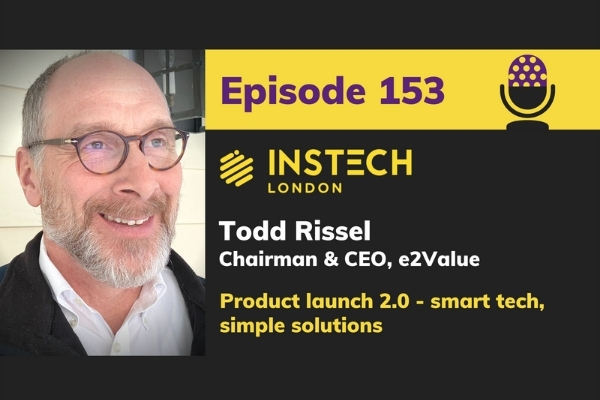When you think of insurance innovation there is a whole host of exciting start-ups and scale-ups that spring to mind, but this week’s podcast guest has been consistently innovating for the past two decades.
Todd Rissel founded e2Value 20 years ago and has built a company that now provides Insurance to Value (ITV) data and products to over 500 clients in the US and Canada.
Matthew and Todd discuss how e2Value has managed to stay relevant and move with the times, including its latest product offerings for estimating repair costs and gathering data about property characteristics.
Talking points include:
- Why insurance knowledge matters when building technology
- How to maintain customer relationships
- Creating a digital, scalable underwriting process
- Working with partners to refine new products
- How companies approach innovation – UK vs the US
e2Value was named as one of the companies to watch in our Location Intelligence 2021 report, which is available to download from our website and free to InsTech London members.
More information on Structure Insurance Score (SIS) is available on the Willis Towers Watson website.
To find out more about Inspect Connect, go to inspectconnect.com.
More e2Value content from InsTech London is available on the company’s member profile page.
If you like what you’re hearing, please leave us a review on whichever platform you use, or contact Matthew Grant on LinkedIn.
Sign up to our newsletter for a fresh view on the world every Wednesday morning.
Continuing Professional Development – Learning Objectives
InsTech London is accredited by The Chartered Insurance Institute (CII). By listening to an InsTech London podcast, or reading the accompanying transcript, you can claim up to 0.5 CPD hours towards the CII member CPD scheme.
The Learning Objectives for this podcast are:
- Understand the Structure Insurance Score (SIS) and how it works in the insurance market
- Compare some of the ways innovation differs in the US and UK
- Recognise where innovation in the industry might be heading
To continue learning about innovation in insurance, read our insight Covid-19 – Insurance innovation your time has come.
Let us know you have listened to this podcast and if your organisation is a member of InsTech London you will receive a quarterly summary of the CPD hours you have earned.
To help us measure the impact of the learning, we would be grateful if you would take a minute to complete a quick feedback survey.
Product launch 2.0 – smart tech, simple solutions – Episode 153 highlights
Matthew: How has e2Value innovated over the years?
Todd: The DNA of e2Value is from insurance – myself and George Moore, the co-founder, both worked at an insurer. Most people that work at e2Value have a background in insurance, so we have a good understanding of the industry. We also understand technology. We started the company because there was a need in the marketplace. By listening to our clients, we understand what challenges they face. Staying in touch with them is a key reason why we have as many clients as we do.
Matthew: e2Value helps over 500 companies understand the rebuild cost of buildings in the US and Canada. In the US, am I right in thinking that if people don’t get the cost right, they can have their payment reduced?
Todd: Yes. The law here is that the person who insures the structure is responsible for the value. At the moment, there’s some legal action going on in California. The current rule may change but for now, the person who takes out the policy is responsible for it.
Matthew: Can you talk about e2Value’s Structure Insurance Score (SIS)?
Todd: The idea is to separate the value of a home from what is going to happen to it. The three main categories that drive losses are fires, water from inside the home and weather. A lot of insurers’ rating plans are based on the estimated sale value of a property. This is misleading. Losses are going to affect homes the same way, whether the market value is $400k or $800k. SIS assesses a home and breaks it down to its propensity to damage, and then how expensive it is to repair. Willis Towers Watson worked with us on defining the analytics to create the score. The tool uses e2Value’s home data and combines it with Willis Towers Watson’s analytics on pricing and losses. The score provides another way for insurers to estimate pricing for homes, and to separate the market value from the rate calculation.
Matthew: How are sales of SIS getting on in the market?
Todd: Insurers buy the product through Willis Towers Watson. In the last five years, Willis has filed the insurance rates with most states – we’re up to over 40 states with acceptance now. The longest part of the journey has been working to integrate the SIS with policy administration systems. BriteCore has done this for us. In 2022, we will have other policy administration companies enabling our mutual clients to use the SIS.
Matthew: For those who aren’t familiar with the US, admitted carriers need to get approval from the insurance commissioner in each state. Do they review the rates coming out of the SIS tool?
Todd: Yes. The SIS is a brand new tool, so the insurance commissioners need to make assessments such as ensuring it is not penalising a certain part of the population for example.
Matthew: Can you talk about any of your partners?
Todd: We have a lot of partners. There’s a good chance that if someone is shopping for home insurance, e2Value technology has been used in the background to figure out if it is a good risk or if it met the insurer’s profile. We partner with some other InsTech London members, such as HazardHub, for GIS information. We also work with another GIS provider, Maprisk.
Matthew: Tell me about your new product, Inspect Connect.
Todd: Inspect Connect is a simple way for underwriters to text or email the broker or client to verify the information on new insurance applications. It then takes just a few minutes for the end-userend user to confirm the information or answer a question or take a picture if necessary. With this short interaction, everything can be sorted out right at the beginning of writing the policy.
Matthew: Have you seen a good take-up of the product?
Todd: Yes, we have a number of beta clients. We introduced Inspect Connect to them this summer, with the idea that they would tell us what we got right or wrong. From September some clients will start using it, with insurers starting in November or December. There’s a lot of regulation around how someone can be texted, so the insurance part was fairly easy compared to ensuring we met that type of compliance for contacting people.
Matthew: What’s your perception of the approach to innovation in the UK versus in the US?
Todd: There’s more discussion about innovation in the UK and there’s a greater interest in bringing products to market. It’s a smaller market than the US, so in certain ways, it’s easier. Another reason is how inexpensive home insurance is in the UK compared to the US. When premiums are that low, there are less margins, so there are benefits of using technology to improve margins.
Matthew: We’re delighted to have you supporting us for our 11 October live event back at The Steel Yard. Is there anything in particular you would like to talk to people about when you’re over?
Todd: I enjoy InsTech London’s events very much – I’m always impressed with the audience. In the UK, insurers are more geographically concentrated than in the US so a lot of good companies can turn up to an event. People can have great discussions with a broad range of people. I’m looking forward to just seeing people as I’ve been stuck inside for so long.
Matthew: What do you think the future for innovation is?
Todd: The automobile and the aeroplane were invented at roughly the same time, but one didn’t replace the other – they work together. In an insurance context, lots of companies have innovated and stayed relevant. That’s a great challenge for us all, but one piece of innovation does not have to replace another.






